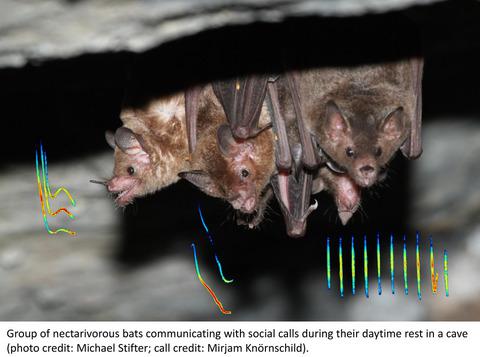当前位置:
X-MOL 学术
›
Funct. Ecol.
›
论文详情
Our official English website, www.x-mol.net, welcomes your
feedback! (Note: you will need to create a separate account there.)
Vocal information and the navigation of social decisions in bats: Is social complexity linked to vocal complexity?
Functional Ecology ( IF 4.6 ) Pub Date : 2019-07-27 , DOI: 10.1111/1365-2435.13407 Mirjam Knörnschild 1, 2, 3 , Ahana Aurora Fernandez 1, 3 , Martina Nagy 1
Functional Ecology ( IF 4.6 ) Pub Date : 2019-07-27 , DOI: 10.1111/1365-2435.13407 Mirjam Knörnschild 1, 2, 3 , Ahana Aurora Fernandez 1, 3 , Martina Nagy 1
Affiliation

|
To make adaptive behavioural decisions, animals must acquire and process information from their natural and social environment. Reducing uncertainty regarding the actions and goals of conspecifics is especially important for group‐living animals. Bats are often highly gregarious and use versatile social vocalizations to mediate social interactions. These social vocalizations encode a substantial amount of ecologically relevant information, such as individual identity, sex and kin. Decoding this information enables receivers to make informed decisions on resource allocation, mate choice, territorial defence and cooperation. Erroneous decisions on such crucial aspects of bats’ social behaviour can be costly due to reduced reproductive success or survival. Increasingly complex social interactions require social vocalizations encoding more information which, in turn, could facilitate the evolution of even more complex social interactions. Evidence for the positive correlation of social and vocal complexity is available for several taxa but is currently very limited for bats. We conducted a phylogenetic comparative analysis to link the information content encoded in bats’ social vocalizations to the complexity of their social lives, that is the level of uncertainty associated with assessing individual identity. We focused on three different vocalization types encoding individual signatures (pup isolation calls, adult contact calls and male‐specific vocalizations). Information content in bit (i.e. the number of binary decisions necessary to discriminate among N individuals) was used as an estimate of vocal complexity; relevant social group size (i.e. the number of conspecifics whose identity a receiver could confuse) was used as an estimate of social complexity. Our phylogenetic comparative analysis detected a positive relationship between the information content of vocalizations and the respective relevant social group size. This relationship suggests a positive feedback loop between social and vocal complexity for bat vocalizations and highlights the importance of vocal information for negotiating fitness‐relevant social decisions of bats. In conclusion, our work suggests that social complexity drives vocal complexity in bats. Future studies on other hitherto understudied taxa are necessary to establish a comprehensive theory on the multi‐faceted co‐evolution of sociality and communication in the animal kingdom. A free Plain Language Summary can be found within the Supporting Information of this article.
中文翻译:

蝙蝠的声音信息和社会决策导航:社会复杂性与声音复杂性有关吗?
为了做出适应性行为决策,动物必须从其自然和社会环境中获取和处理信息。减少关于同种动物的行动和目标的不确定性对于群居动物尤其重要。蝙蝠通常高度合群,并使用多种社交发声来调解社交互动。这些社会发声编码了大量与生态相关的信息,例如个人身份、性别和亲属。解码此信息使接收者能够在资源分配、配偶选择、领土防御和合作方面做出明智的决定。由于繁殖成功率或存活率降低,对蝙蝠社会行为的这些关键方面做出错误决定可能代价高昂。越来越复杂的社交互动需要社交发声来编码更多信息,这反过来又可以促进更复杂的社交互动的演变。社会和声音复杂性正相关的证据可用于几种分类群,但目前对蝙蝠来说非常有限。我们进行了系统发育比较分析,将蝙蝠社会发声中编码的信息内容与其社会生活的复杂性联系起来,即与评估个体身份相关的不确定性水平。我们专注于编码个体特征的三种不同的发声类型(幼犬隔离叫声、成年接触叫声和雄性特定发声)。以比特为单位的信息内容(即 区分 N 个个体所需的二元决策的数量)被用作对声音复杂性的估计;相关的社会群体规模(即接收者可能混淆其身份的同种人的数量)被用作社会复杂性的估计。我们的系统发育比较分析检测到发声的信息内容与相应的相关社会群体规模之间存在正相关关系。这种关系表明,蝙蝠发声的社会和声音复杂性之间存在正反馈循环,并强调了声音信息对于协商蝙蝠的健康相关社会决策的重要性。总之,我们的工作表明,社会复杂性推动了蝙蝠的声音复杂性。未来对其他迄今尚未研究的分类群的研究对于建立关于动物王国社会性和交流的多方面协同进化的综合理论是必要的。可以在本文的支持信息中找到免费的普通语言摘要。
更新日期:2019-07-27
中文翻译:

蝙蝠的声音信息和社会决策导航:社会复杂性与声音复杂性有关吗?
为了做出适应性行为决策,动物必须从其自然和社会环境中获取和处理信息。减少关于同种动物的行动和目标的不确定性对于群居动物尤其重要。蝙蝠通常高度合群,并使用多种社交发声来调解社交互动。这些社会发声编码了大量与生态相关的信息,例如个人身份、性别和亲属。解码此信息使接收者能够在资源分配、配偶选择、领土防御和合作方面做出明智的决定。由于繁殖成功率或存活率降低,对蝙蝠社会行为的这些关键方面做出错误决定可能代价高昂。越来越复杂的社交互动需要社交发声来编码更多信息,这反过来又可以促进更复杂的社交互动的演变。社会和声音复杂性正相关的证据可用于几种分类群,但目前对蝙蝠来说非常有限。我们进行了系统发育比较分析,将蝙蝠社会发声中编码的信息内容与其社会生活的复杂性联系起来,即与评估个体身份相关的不确定性水平。我们专注于编码个体特征的三种不同的发声类型(幼犬隔离叫声、成年接触叫声和雄性特定发声)。以比特为单位的信息内容(即 区分 N 个个体所需的二元决策的数量)被用作对声音复杂性的估计;相关的社会群体规模(即接收者可能混淆其身份的同种人的数量)被用作社会复杂性的估计。我们的系统发育比较分析检测到发声的信息内容与相应的相关社会群体规模之间存在正相关关系。这种关系表明,蝙蝠发声的社会和声音复杂性之间存在正反馈循环,并强调了声音信息对于协商蝙蝠的健康相关社会决策的重要性。总之,我们的工作表明,社会复杂性推动了蝙蝠的声音复杂性。未来对其他迄今尚未研究的分类群的研究对于建立关于动物王国社会性和交流的多方面协同进化的综合理论是必要的。可以在本文的支持信息中找到免费的普通语言摘要。











































 京公网安备 11010802027423号
京公网安备 11010802027423号